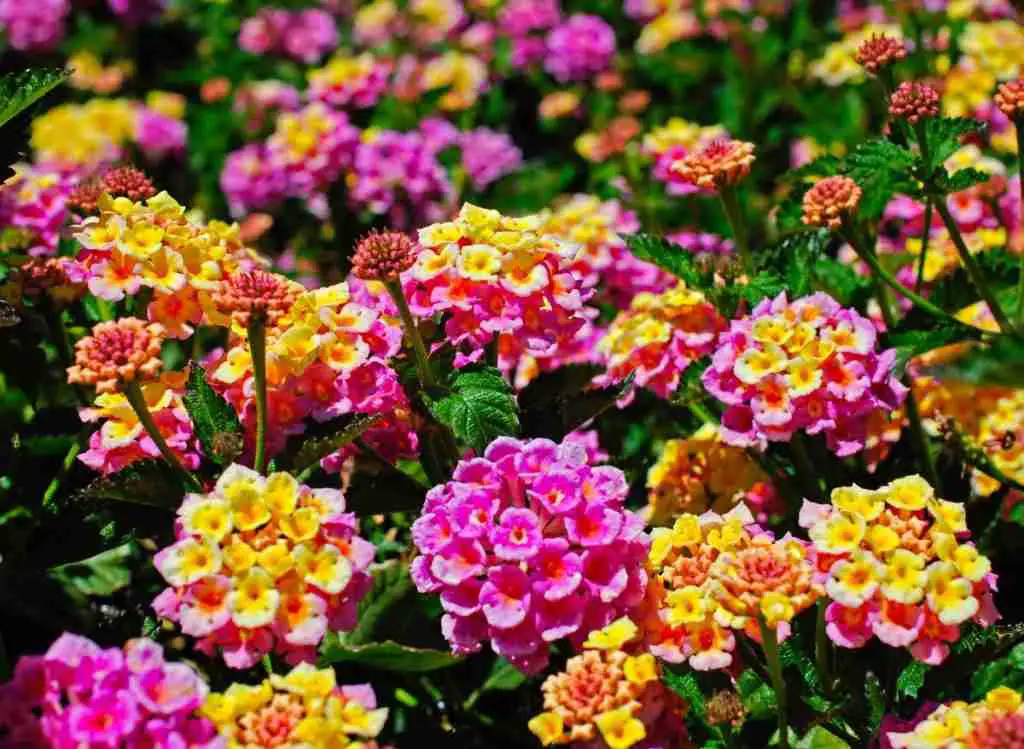
Lantanas make an excellent choice, particularly if you wish to attract bees, butterflies, and hummingbirds to your garden. And the most common lantana is an orange, red, or yellow flower, but some produce pink or purple flowers or even a blend of many colors. Depending on the variety of lantana, they can grow about eight feet tall and four feet wide.
The flowers are often fragrant and pollinators magnet, including bees, butterflies, and hummingbirds. Growing lantana in your garden is a great way to add color and interest. However, finding the best companion plants for your lantana is not always an easy task.
This guide will discuss everything you need to know about the lantana plant, how to care for it, the different varieties of lantana, and the best companion plants for lantana you need to know about.
See also: 5 Of The Best Companion Plants For Your Olive Trees To Know About.
Lantana Plant and Their Characteristics
If you have hot and dry spots in your garden where most plants have time to grow, try planting lantana.
Lantana is a pollinator-friendly, easy-to-grow, low-maintenance plant with colorful flowers that thrives with little moisture in the full, challenging, and unyielding sun.
The table below contains the lantana plant and its characteristics:
| Genus Name | Lantana |
| Light | Sun |
| Plant type | Annual or Perennial |
| US Zones | 8 9 10 11 |
| Height | – 6 to 12 inches – 1 to 3 feet – 3 to 8 feet |
| Width | 16 inches to 4 feet |
| Blooming Seasons | – Fall Bloom – Summer Bloom |
| Flower Main Colors | – Purple – Red – Orange – White – Pink – Yellow |
| Foliage color | – Blue/Green – Chartreuse/Gold |
| Care | – Low Maintenance – Attracts Birds – Good for Containers |
| Special features | – Deer Resistant – Drought Tolerant |
| Propagation | Seed Stem Cuttings |
Different Types of Lantana
| Types of Lantana | Characteristics |
| ‘Bandana Cherry’ Lantana | Offers abundant and rich yellow, orange, and cherry-red blooms in large heads. |
| ‘Irene’ Lantana | Bears pink, bright yellow, and red florets in large clusters on a growing plant |
| ‘Lucky Peach’ Lantana | Offers heads of orange-peach flowers that develop to peachy-pink on compact plants. |
| ‘Landmark Pink Dawn’ Lantana | Offers creamy yellow flowers maturing to soft pink |
| Lantana montevidensis | It can reach about 3 feet tall and 4 feet wide. |
| ‘Luscious Grape’ Lantana | Grows about 16 inches tall and 36 inches wide and displays clusters of lavender-purple flowers on a floriferous and vigorous plant. |
| ‘Lucky Pot of Gold’ Lantana | Offers heads of rich yellow flowers on compact plants |
| ‘Luscious Citrus Blend’ Lantana | It grows about 3 feet (91.44 cm) tall and wide and is a heat-loving collection with vibrant red, orange, and yellow blossoms on a mounding plant. |
| ‘Patriot Firewagon’ Lantana | It offers bunches of yellow flowers that will turn bright yellow and then red-orange. |
| ‘Samantha’ Lantana | This type of lantana has yellow blossoms and golden-variegated foliage. |
How to Properly Grow Lantana Flowers
In general, the size of lantana varies. In hot southern climates, lantana can be considered a perennial or tropical plant and grow 10 feet tall. But, the plant is treated as an annual in most environments and reaches about 3 feet in one growing season.
Lantana plants are extremely low-maintenance plants, but newly planted lantanas need frequent watering. After your lantana is established, watering them once per week will keep your lantana relatively happy.
To encourage your lantana to rebloom by cutting the tips (deadhead) regularly. You can also give new life to your flowers by cutting back a third of their growth, and they will bounce back quickly. Generally, spring is the best time for plant pruning.
During the cool spring season, a lantana plant may grow a little slow to start; however, the plant will quickly grow as soon as temperatures rise.
In addition, lantana plants will thrive in the warmest and sunniest areas, and they will quickly produce rich foliage and abundant, colorful blooms.
To help get the plant started, you may give lantana a bit of fertilizer, but it does not require much. And keep in mind that too much fertilizer may prevent it from blooming.
If your lantana plant becomes overgrown, you can prune it back. In addition, lantana can be treated as perennial in frost-free climate zones and as annual in climates with harsh winters.
Tips On Planting and Maintaining Lantana Plants
- Pick a sunny location and plant your lantana in well-draining soil. Even though you can grow lantana in various soil conditions, lantana flowers prefer slightly acidic soil.
- It is essential to consider placement mainly because lantanas thrive in full sun and warmth.
- Generally, plants are likely to produce fewer blooms and are more susceptible to disease when in too much shade. In areas with too much moisture, powdery mold, and root rot are more likely to appear.
- You can start older varieties of lantana from seed.
- Since many new lantana varieties don’t produce seed, you can only propagate new ones by stem cuttings of young growth that hasn’t gotten too woody.
- Lantana does well in areas with full sun and requires modest amounts of water. Applying too much fertilizer or water may decrease its bloom.
- Heavy freezes may kill plants. Prune to remove deadwood.
Lantanas Are Pollinator-friendly
Lantanas are pollinator-friendly. It is common to observe many bees, butterflies, and hummingbirds clustering around lantana plants, sipping up the rich and abundant nectar produced in their small, tubular blooms.
Best Companion Plants For Lantana
Lantana thrives as a stand-alone plant, but you can also pair it with other plants that enjoy the sun and attract butterflies for gorgeous butterfly garden arrangements.
Here are 5 of the best companion plants for lantana you need to know about.
1- Angelonia
Angelonia (AKA summer snapdragon) is a beautiful plant that thrives well with heat and flowers throughout the season, making it an excellent choice for flower beds and containers. It is the perfect plant for combining bright colors with hot, sunny spaces.
Angelonia is one of the best companion plants for lantana. Sometimes referred to as “summer snapdragon,” angelonia produces many snapdragon-like flowers that come in white, pink, lavender, or purple, depending on the cultivar.
It has salvia-like flower spires that stand a foot or two high, studded with gorgeous snapdragon-like flowers with beautiful purple, pink, or white colorations.
See also: How To Make Bug A Salt Even More Powerful: Here’s How
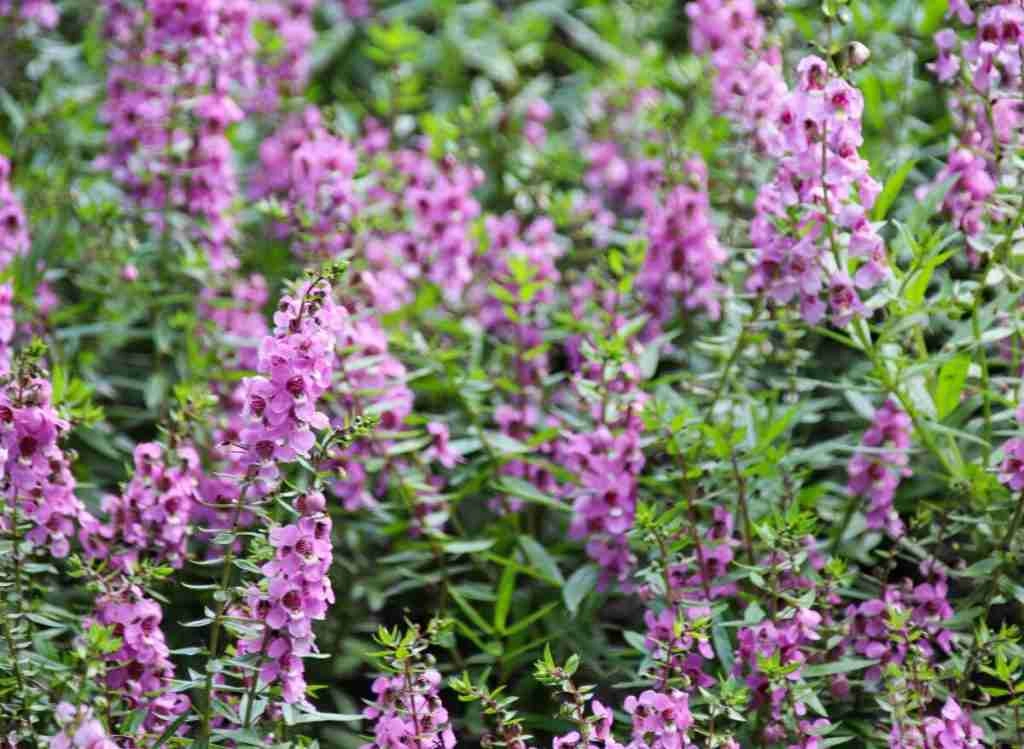
Similar to lantana, angelonia is a tough plant that blooms all summer long with spirelike spikes of blooms. While all types are beautiful, watch out for the sweetly scented selections.
Even though most gardeners treat angelonia as an annual, it is actually a tough perennial in Zones 9-10. You can also keep it flowering all winter if you own a bright, sunny spot indoors.
| Genus name | Angelonia Angustifolia |
| Common Name | Summer snapdragon, angelonia |
| Plant Type | Typically behave as a perennial in hot weather unless exposed to a cold winter. |
| Height | – 1 to 3 feet – 1-2 feet wide |
| Flower color | – Blue – Purple – Red – White – Pink |
| Soil Type | Average, well-draining |
| Watering Requirements | – In general, angelonia plants are tough and will keep on blowing through periods of drought. – Water angelonia plants when the top of the soil feels dry. Also, if your angelonia plants have good drainage, moisture should be fine. |
| Soil pH | – 18 to 24 inches – Acidic |
| Bloom Time | Summer (To increase performance, plant angelonia in late spring in a place that receives full sun and has moist, well-drained soil. Once established, angelonia can be pretty drought-tolerant, mainly if the soil is rich in organic material and added a layer of mulch) |
| Hardiness USDA Zones | 9–11 |
| Fertilizer | – Fertilize angelonia plants with a light, monthly application of a 10-5-10 fertilizer or similar mix. – Do not over-fertilize. If overfertilized, angelonia will produce more leaves and fewer flowers. |
| Maintenance requirements | – Good for Containers – Low Maintenance (but angelonia can occasionally develop powdery mildew or suffer from aphid infestations) |
| Propagation | – Stem Cuttings – Seed |
2- Salvia
Salvia is drought-tolerant and attracts hummingbirds, bees, and butterflies, particularly the red ones, and are excellent picks for hot, dry sites where you like to see tons of color all season. Most salvias don’t enjoy cool weather, so preferably plant them outdoors after all danger of frost has passed.
If you wish to attract pretty pollinators, such as hummingbirds, butterflies, and bees, salvia is an excellent companion plant for lantana.
See also: Top 10 Garden Fence Security Ideas To Check Out!
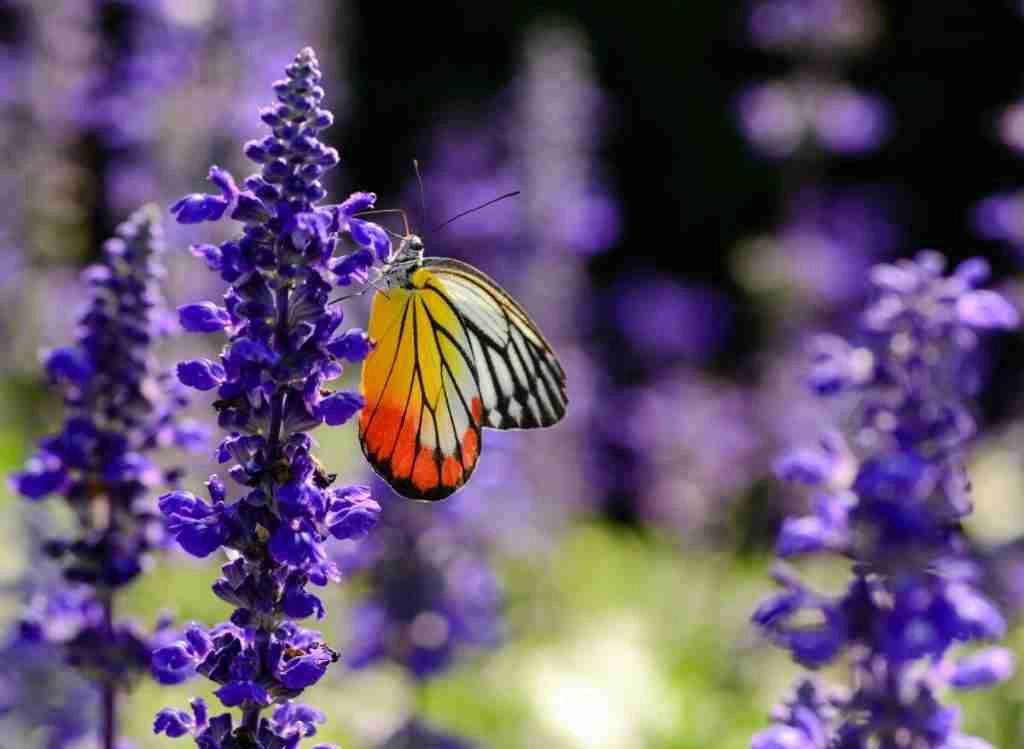
All salvias grow well in full sun and well-drained soil; however, a south-facing location is ideal.
How To Plant Salvia
- Start by preparing and loosening your soil to a depth of 12 inches.
- Mix in about a 3-inch layer of compost to provide rich nutrients.
- If you use a container, add some grit to the compost to promote drainage and feed in spring.
- Dig a hole two times the diameter of the container the plant comes in.
- Take the plant off its container and put it in the hole to ensure that the top of the root ball is level with the soil surface.
- Space salvia plants about 1 to 3 feet apart, depending on the variety.
- Firm your soil gently and carefully. Fill in around the plant.
- Water generously.
3- Shrubs
Lantana thrives best in full sun but will also tolerate some afternoon shade, so it is best to choose companion plants for lantana that are also sun-lovers. Shrubs are one of the best companion plants for lantana.
Similar to lantana, most shrubs are pretty drought-tolerant after they are established. However, for the first year after planting, you will want to ensure your shrub stays well-watered.
See also: Tulip Vs. Rose: What Is The Difference Between Both?
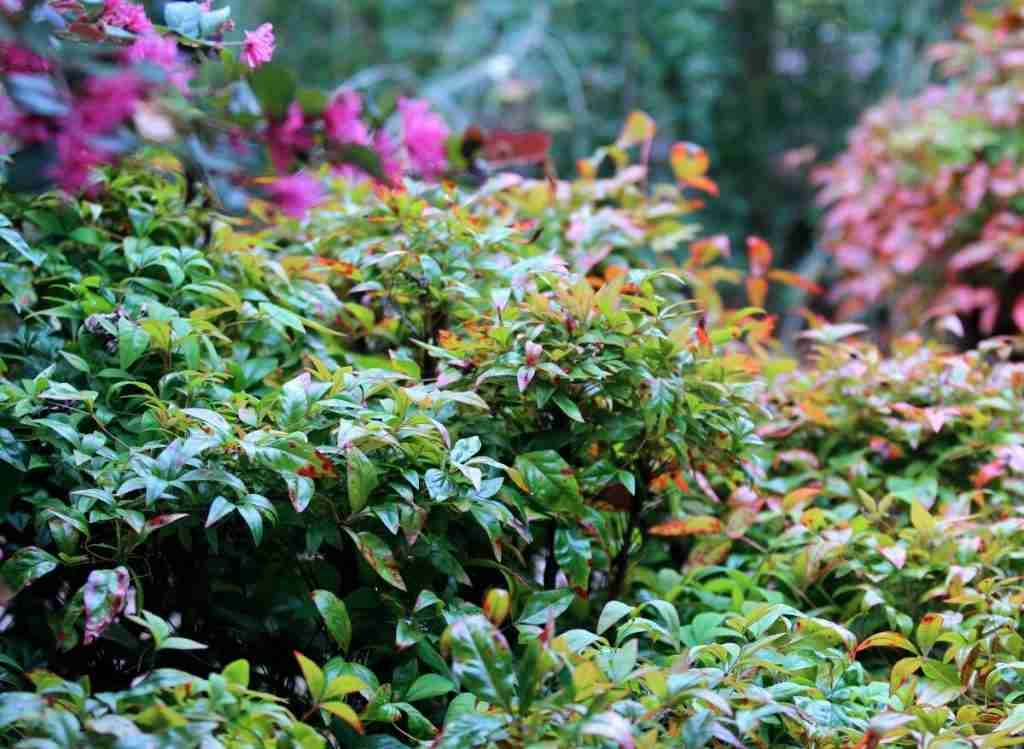
Look for shrubs that tolerate desert heat and poor soil to grow next to the lantanas. Adding shrubs can turn your landscape into a beautiful, vibrant showpiece making your garden more inviting.
Types of Shrubs
| Types of Shrubs | Characteristics |
| Forsythia | – It grows typically 8 to 10 feet tall. – Ideally, grown in well-drained, full sun or part sun, evenly moist soil. – Hardy in Zones 4-9. |
| Boxwood | – Most boxwood grows to 20 feet tall. – Even though it can tolerate drought, it will ideally grow in sun or light shade, preferably well-drained soil. – Hardy in Zones 4-8. |
| Andromeda (AKA lily-of-the-valley bush) | – Andromeda can also tolerate full sun and a 4-to-12-foot tall broadleaf evergreen – Requires well-drained soil that is not too dry or too wet. – Hardy in Zones 6-9. |
| Oleander | – Like lantana, oleander also tolerates heat, full sun, and drought and can survive in any soil. – Hardy in Zones 9-11. |
4- Pentas
Pentas are among the best pollinator-attracting plants and an excellent food source for hummingbirds, butterflies, and bees.
In addition, pentas grow well both in the ground and in containers and make an excellent companion plant for lantana.
See also: Top Essential Gardening Tools You Need to Successfully Start Your Garden
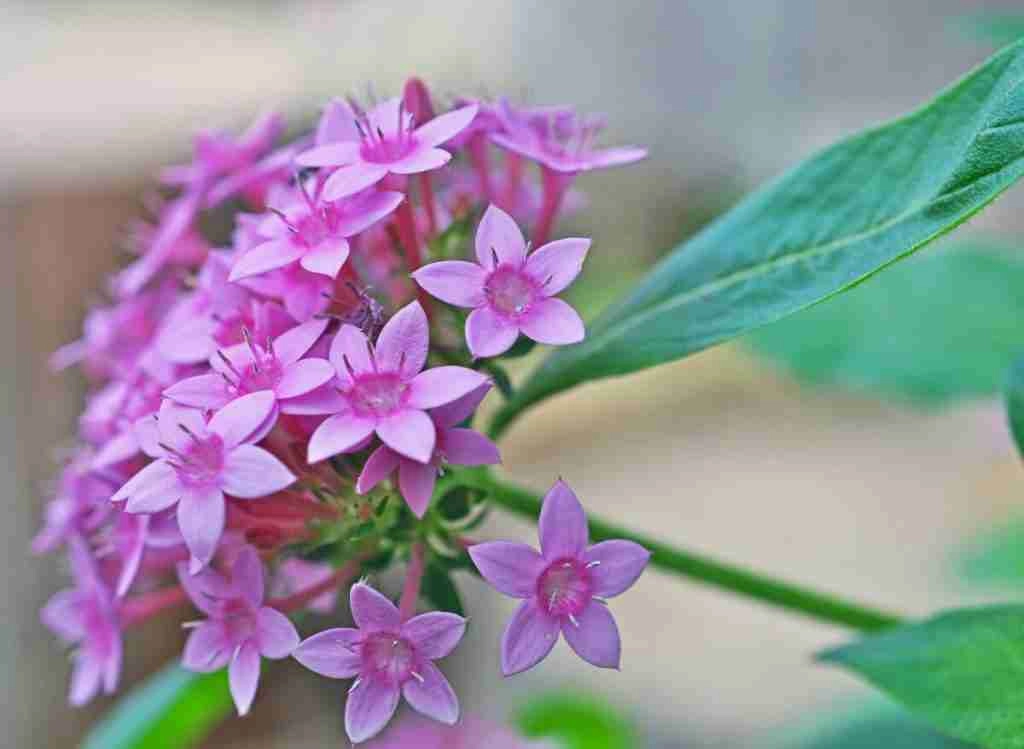
Even though pentas don’t face many problems with disease, the most common issue can be aphids or spider mites. Watch out for these, particularly in the heat of the summer, and make sure that you take care of them at their first manifestations.
You can also put pentas in closer quarters when creating container gardens.
Tips For Care For Pentas Plants:
- For best results, plant pentas in late spring in a place that receives full sun and has well-drained soil
- Water pentas plants regularly at the beginning and then only as needed when rainfall is limited.
- Fertilize with a well-balanced fertilizer every six weeks or so for better performance.
- Most pentas grow approximately 15 inches wide and 2 to 3 feet tall, so ensure that you leave enough space for your pentas to grow if planted in beds.
| Genus name | Pentas lanceolata |
| Light | Sun |
| Plant type | Annual Perennial |
| Height | – 1 to 3 feet – 3 to 8 feet |
| Width | From 12 inches to 4 feet |
| Flower color | – Purple – Red – White – Pink |
| Foliage color | Blue/Green |
| Season features | – Fall Bloom – Summer Bloom |
| USDA Zones | 10 11 |
| Special Characteristics | – Low Maintenance – Attracts Birds – Good for Containers |
| Propagation | – Leaf Cuttings – Seed – Stem Cuttings |
5- Succulents
Like lantanas, succulents also prefer dry, hot growing spaces; they naturally complement each other. In addition, they both do well in containers.
“Autumn Joy” stonecrop
“Autumn Joy” stonecrop (Sedum “Autumn Joy”) is 2 feet tall and wide, with succulent stems and leaves. The succulent stems and leaves can reach 24 inches tall and wide in USDA zones 3 through 11. It also attracts butterflies.
See also: Here’s How Gardening Will Save You a Lot of Of Money?
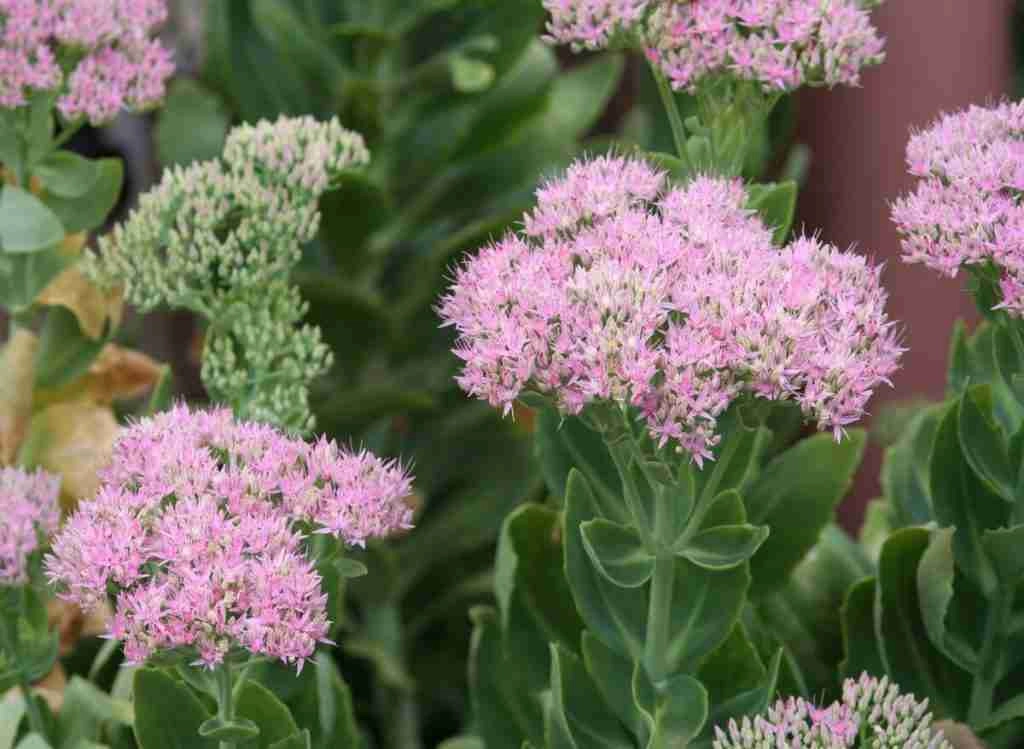
“Autumn Joy” stonecrop is an excellent companion plant for lantana. Below is a snapshot of its main characteristics.
| Botanical Names | Hylotelephium telephium ‘Herbstfreude’ (‘Autumn Joy’), also known as Sedum telephium’ Autumn Joy.’ |
| Plant Type | Herbaceous, perennial |
| Height | 1.5–2 ft. tall and wide |
| Soil Type | – Well-drained – Sandy |
| Soil pH | – Neutral – Acidic – Alkaline |
| Fertilizer requirements | Autumn Joy thrives well in poor soils, so typically, you do not need to feed it. Like lantana, Autumn Joy might like a light spring feeding with a balanced fertilizer if you have impoverished soil. However, excessive fertilizing can cause leggy growth. |
| Watering | Autumn Joy does not require much water and has excellent drought tolerance. In the heat of summer, light watering every two weeks or so is enough. Additionally, more frequent watering can cause the roots to rot. |
| Bloom period | – Summer – Fall |
| Common flower color | – Rust red – Pink, |
| Hardiness USDA Zones | 3–9 |
| Sun Exposure | It requires full sun exposure. At least six hours of direct light; however, shady conditions can make Autumn Joy” stonecrop leggy and reduce flower production. |
| Maintenance requirements | Autumn Joy stonecrop requires low maintenance if you give it the right growing conditions. |
Wrapping Up
No matter what companion plants you choose for lantana, your container or garden will be full of attractive blooms all season.
Few plants require so little care and look beautiful all season long, even in hot, dry weather. Use lantana to add great color to a sunny balcony, porch, or patio.


